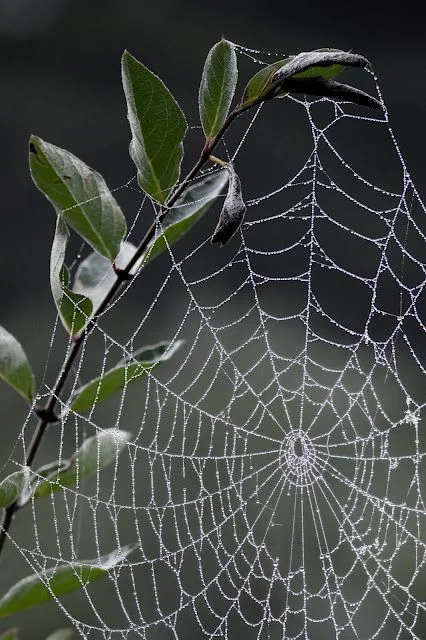Spiderweb is a structure created by spiders using silk produced from their spinnerets. These intricate designs serve as homes, hunting traps, and protection for spiders. While some people admire the beauty of spider webs, others find them unsettling, especially when they appear in large numbers around homes.
In Canada, common spiders like the marbled orb weaver create stunning orb webs, while others leave behind messy cobwebs. Understanding the difference between a spider web vs cobweb can help homeowners identify the type of spider activity in their property.
Types of Spider Webs Found in Canada
1. Orb Webs (Orb Spider Web)
The classic orb web is the most recognizable type, often seen in gardens or between trees. Spiders like the marbled orb weaver create these circular, wheel-like structures to catch flying insects. These spider webs are strong and often rebuilt daily.
2. Cobwebs (Cobweb Meaning)
Unlike the neat orb web, cobwebs are irregular, tangled webs often found in corners of ceilings, basements, or abandoned areas. These are typically made by house spiders and accumulate dust over time, leading to the common phrase “what are cobwebs?”
3. Funnel Webs
Some spiders, like grass spiders, create funnel-shaped webs in lawns or shrubs. These spider webs on lawn areas are flat with a small retreat where the spider hides, waiting for prey.
4. Sheet Webs
Flat and horizontal, sheet webs are common in grass or low vegetation. They act like a net, trapping insects that walk over them.
5. Tangle Webs (Cobweb vs Web)
Similar to cobwebs, these messy, unstructured webs are designed to trap prey through confusion rather than neat patterns.
Why Do Spiders Build Web?
Spiders create webs for spider hunting, shelter, and egg protection. The silk used in what spider webs are made of is a protein-based fiber stronger than steel relative to its size. Spiders like the orb web spider use different silk types for frame threads, sticky capture spirals, and retreats.
Spider Webs vs Cobwebs What’s the Difference?
Many people wonder about the cobweb vs spider web debate. The key difference lies in their structure and purpose:
- Spider webs are actively maintained by spiders for catching prey.
- Cobwebs are abandoned spider webs that collect dust and debris.
If you see fresh, well-structured spider and spider web designs, a spider is likely nearby. Old, dusty cobwebs indicate past spider activity.
How Do SpidersWeb Make ?
The process of how does a spider make webs is fascinating. Spiders produce silk from glands called spinnerets, weaving them into different patterns depending on the species. Web weaving spiders like orb weavers spin silk in concentric circles, while others create irregular tangles.
Common Spiders in Canada That Build Webs
1. Marbled Orb Weaver
Known for its striking colors and large orb spider web, this spider is harmless but often startles homeowners with its size.
2. House Spiders (Cobweb Spider Species)
These small spiders create messy cobwebs in dark corners, basements, and attics.
3. Grass Spiders
They build funnel webs in lawns and gardens, helping control insect populations.
4. Cellar Spiders
Often called “daddy longlegs,” these spiders make loose, irregular cobwebs in damp areas.
Are SpiderWeb Dangerous?
Most spider webs in Canada are harmless and even beneficial, as they reduce insect populations. However, some homeowners dislike the sight of spiders and webs around their property. In rare cases, venomous spiders like the black widow may build webs in secluded areas, requiring professional removal.
How to Prevent Spider Webs in Your Home
To minimize Spiderweb in and around your house, follow these tips:
- Seal Entry Points: Check for gaps around windows, doors, and foundations.
- Reduce Clutter: Spiders love hiding in piles of wood, boxes, or unused items.
- Regular Cleaning: Dust and vacuum frequently to remove cobwebs and discourage spiders.
- Outdoor Maintenance: Trim bushes, grass, and remove debris where spiders may build spider webs on lawn areas.
- Use Natural Repellents: Essential oils like peppermint or vinegar can deter spiders.
How to Remove SpiderWeb Safely
If you find spider cobwebs in your home, here’s how to remove them:
- Use a Vacuum or Broom: Gently sweep away cobwebs from ceilings and corners.
- Dust Regularly: Prevent buildup by cleaning high and low areas where spiders nest.
- Professional Pest Control: For persistent spiderweb problems, IPM Pest Solutions provides safe and effective removal.
When to Call a Professional Pest Control Service
While most spiders and spider webs are harmless, an infestation can become a nuisance. If you notice:
- Excessive spider webs inside your home
- Frequent sightings of spiders in webs
- Signs of venomous spiders (e.g., black widows)
It’s best to contact IPM Pest Solutions for expert spider control in Canada.
Trust IPM Pest Solutions to handle spider and web issues professionally
Understanding spider webs, their types, and how to manage them can help keep your home spider-free. While most spider webs are harmless, regular cleaning and preventive measures can reduce their presence. For stubborn infestations, trust IPM Pest Solutions to handle spider and web issues professionally.
If you’re dealing with persistent cobwebs or spider webs in your Canadian home, contact us today for a customized pest control solution!





